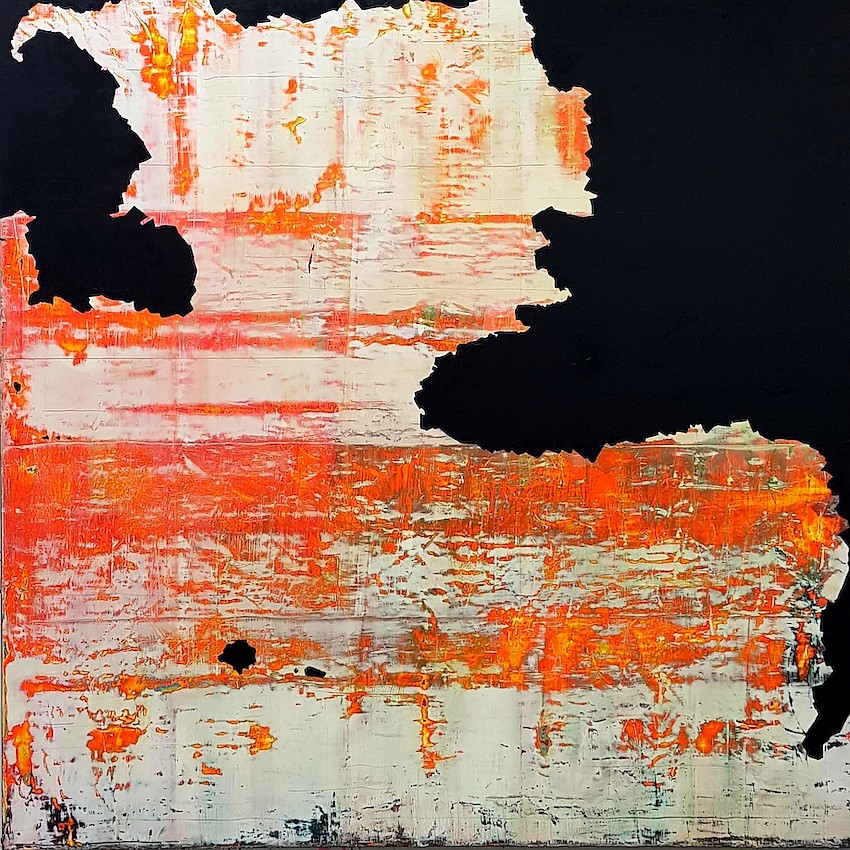PRESS RELEASE

PHILIPPE UZAC: Quest
Feb 22 – Mar 12, 2020
PHILIPPE UZAC
QUEST
EVERARD READ’S CIRCA GALLERY
2 JELLICOE AVENUE ROSEBANK
22ND FEBRUARY – 14TH MARCH 2020
My studio is located in the inner city industrial fringes. Downtown Johannesburg is an area that has tentatively been recovered from deterioration. Some of its surroundings are still rusted, stained, faded or disjointed… forming interesting patterns with rich textures, colours and tones in which any attentive observer can find beauty. A panel of veined wood’s paint peeling off, exposing ancient layers of colours - or the raw weathered wood itself - carries beauty and nostalgia. Old cement floors waxed patiently and unremittingly over the years, rusting industrial equipment abandoned in a forlorn wasteland or walls of old buildings stained and patched with layers of paper board teared off and hanging in the wind, are a source of constant inspiration and instil in me a sense of abandonment and melancholy. I look for an aesthetic in decay and try to capture it on canvas and on wood panels that I use as support to my work.
The process starts with a layer of black paint. Black is the absence of light and evokes the “Nothingness”, so dear to Martin Heidegger. But black is also one of the first colours used by man in the Neolithic so, although “Nothing” is on the canvas at this stage of the process, it carries already the potentiality of “Everything”. The dark canvas stays in a corner of my studio, maturing. It is the most powerful object, something like a black hole that devours all. Eventually I cover the canvas with a first layer of colour. The process is then unleashed and entails at times up to fifteen layers of oil paint. It is a long process as it consists of the multi-layering of oil material - concocted in my studio with imported pigments - each layer needing to dry and to be “worked out” before the next one can be applied. I reproduce the effects of time using tools such as knives and spatulas, but also chemicals and waxes, sandpaper and glue. It is a gruelling and physical exercise, constantly scratching, rubbing and sanding layers off. It requires patience and the “right” configuration of all elements involved. It is a chaotic process that only terminates when, standing in front of the work, all inner tension is gone.
The work is abstract in essence, each piece being an object that stands by itself. Its resonance is “fuelled” by the black matter underneath, so powerful that sometimes it devours the layers of colour covering it. Works can be perceived at different scales, something like fractals. One of my favourite ways to look at them, is close to the canvas, exploring the complexity of shapes, textures and colours which play with my emotions and intellect. “I always have the impression, that I write the same book” says the Nobel prize winner of Literature, Patrick Modiano. I could say the same about my work. This repeated process has existential connotations: Is there anything at all under the coloured layers of life that inevitably fade away with time? Abstract painting is a solitary and sometimes arduous experience enshrined by meaning. One cannot venture into abstraction lightly. Essential questions arise inevitably during the process and answers, if any, are never simple. One must accept this mystery with humility and understand that more than a creative process, abstract painting is a quest in its rawest form.



